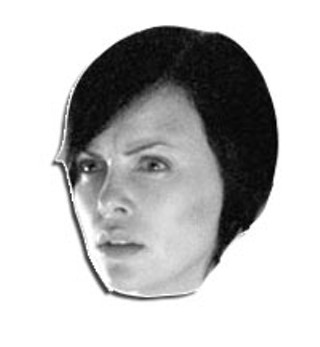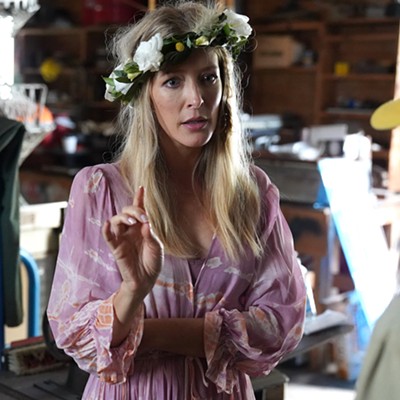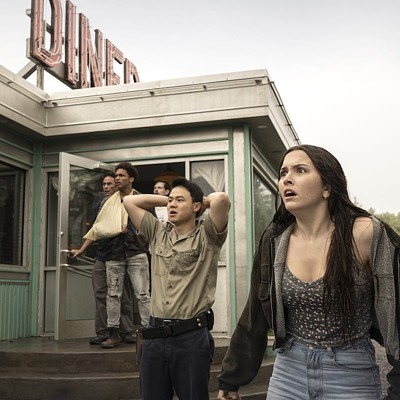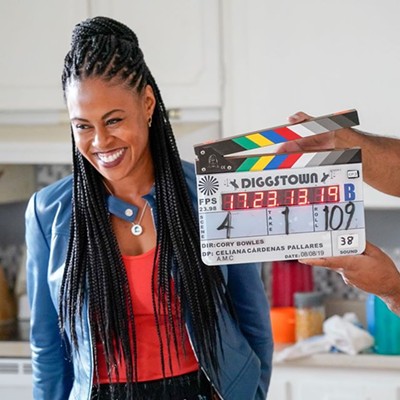The visual excitement of Peter Chung’s MTV series Aeon Flux is lost in transition from animation to live action. Weird pop art becomes routine. There’s a sincere effort to recreate a cartoon look. Director Karyn Kusama (returning five years after her festival hit Girlfight) imbues horizontal line structures through the designs of Earth’s last city Bregna and finds angles that accentuate star Charlize Theron’s big anime eyes. It’s a look that’s only interesting, however, when reflecting upon its animated origins. As stand-alone live action, this world isn’t unique. Aeon Flux’s science fiction now plays as a retread of this year’s already derivative The Island. The characters have clouded histories, so even Oscar-chaser Theron is working against a rounded performance in the title role. Ae-yawn Flux is the latest incident of a talented actress trying to latch on to the commercial longevity of a superhero franchise — Angelina Jolie in Tomb Raider, Halle Berry in Catwoman, Jennifer Garner in Elektra. (We’ve won their middlebrow parents. Now let’s get their dorky kids!) Is it possible that any of them believe these scripts are good? When Kusama delivers an expertly edited action sequence, the movie perks up. But the movie’s over just as it starts getting better. Aeon’s mission is to kill ruler Trevor Goodchilde (Martin Csokas), which will free Bregna’s oppressed citizens. In this sense, the story’s concern becomes akin to the viewer’s: Awaiting escape from boring imprisonment.
Cake
Canadian films imitating US romantic comedies is one thing, but in the case of the murky pastel look of the lazily assembled Cake, it’s too evidently an amateur knockoff. At least the current US release Just Friends has a funny scene about cultural division surrounding The Notebook. And In Her Shoes makes an honest appeal to the pangs of sisterhood. What Cake seems to promise in taking the unorthodox tack of following the heart of a promiscuous woman (Pippa, played by Heather Graham) soon makes way for an unfunny treatise on the importance of romantic commitment. Commitment denotes Pippa’s delayed emergence into the world of adult responsibility. Even as a status quo celebration, that’s startling.
In the Mix
Pop star Usher has been in movies before, but In the Mix is his first to serve primarily as a celebrity vehicle. In the beginning, Usher recites a line from his Alicia Keys duet “My Boo,” and later gets to reenact the centerpiece of most of his videos by taking off his shirt. He plays club DJ Darrell, who is invited to a celebration at the home of an Italian family he’s been friends with since childhood. The party ends in the bad way that all Italian parties end: opposing mob members pull a drive-by, shooting through the house windows. Darrell is shot in the shoulder — a feat that impresses mob boss Frank (Chazz Palminteri) enough to hire Darrell as a human shield for his daughter Dolly (Emmanuelle Chriqui, who was also the magnet of pop idol Lance Bass in the similarly titled On the Line). The illicit affair between Darrell and Dolly has a chance to build interestingly on media perceptions of African-Americans and Italians — who are both stereotyped and mystified in pop culture. “I heard black men can dance,” Dolly taunts. “I heard Italian women can get you in trouble,” Darrell replies. That exchange places race at the forefront of In the Mix, but the movie skirts dumbly around it as an issue. Falling back on dumb cliche, Darrell repays Dolly for showing him the world of mob violence by taking her out for fried chicken, and then to a cookout. People richer than you are paid to come up with this stuff.
Not richer than you: [email protected].













